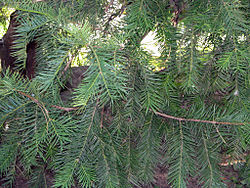| Origin: | ✈ | ? |
|---|
| Exposure: | ☼ | ?"?" is not in the list (sun, part-sun, shade, unknown) of allowed values for the "Exposure" property. |
|---|---|---|
| Water: | ◍ | ?"?" is not in the list (wet, moist, moderate, dry, less when dormant) of allowed values for the "Water" property. |
|
Torreya > |
Read about Torreya in the Standard Cyclopedia of Horticulture
|
|---|
|
Torreya (named for Dr. John Torrey, one of the most distinguished of the earlier American botanists; 1796-1873). Syns., Tumion, Caryotaxus. Taxaceae. Ornamental evergreens, grown for their handsome foliage and interesting habit. Strong broad trees: lvs. 2-ranked, linear or linear-lanceolate, with 2 narrow glaucous lines beneath, becoming fulvous with age; when bruised the foliage emits a pungent or fetid odor except, in T. grandis: fls. dioecious, rarely monoecious; staminate fls. ovoid or oblong, composed of 6-8 whorls of stamens, surrounded at the base by bud-scales; pistillate fls. consisting of a solitary ovule surrounded at the base by a fleshy aril and several scales: fr. drupe-like, consisting of a rather large seed, with thick woody shell entirely covered by a thin fleshy aril.—Four species in N. Amer. and E. Asia. The hard, strong, and close-grained wood is much valued in Japan for cabinet-making and building. It is very durable in the ground. In this country it has been used for fence-posts. The torreyas are handsome evergreen trees, with spreading usually whorled branches, clothed with yew-like two-ranked dark green foliage; the fruits are drupe-like and about 1 inch long. They are but little known in cultivation and rarely seen in a flourishing condition. The Japanese T. nucifera is the hardiest and has proved fairly hardy as far north as Massachusetts; also T. grandis survives in very sheltered positions in the vicinity of Boston, but the other two species are much tenderer. Torreyas grow best in shaded and sheltered positions and in a somewhat moist loamy soil. Propagation is by seeds; also by cuttings and by grafting on Cephalotaxus. Plants raised from cuttings grow very slowly and usually remain bushy. For cions, terminal shoots should be selected. CH
|
Cultivation
- Do you have cultivation info on this plant? Edit this section!
Propagation
- Do you have propagation info on this plant? Edit this section!
Pests and diseases
- Do you have pest and disease info on this plant? Edit this section!
Species
Torreya californica
Torreya fargesii
Torreya grandis
Torreya jackii
Torreya nucifera
Torreya taxifolia
Gallery
If you have a photo of this plant, please upload it! Plus, there may be other photos available for you to add.
References
- Standard Cyclopedia of Horticulture, by L. H. Bailey, MacMillan Co., 1963
External links
- w:Torreya. Some of the material on this page may be from Wikipedia, under the Creative Commons license.
- Torreya QR Code (Size 50, 100, 200, 500)
